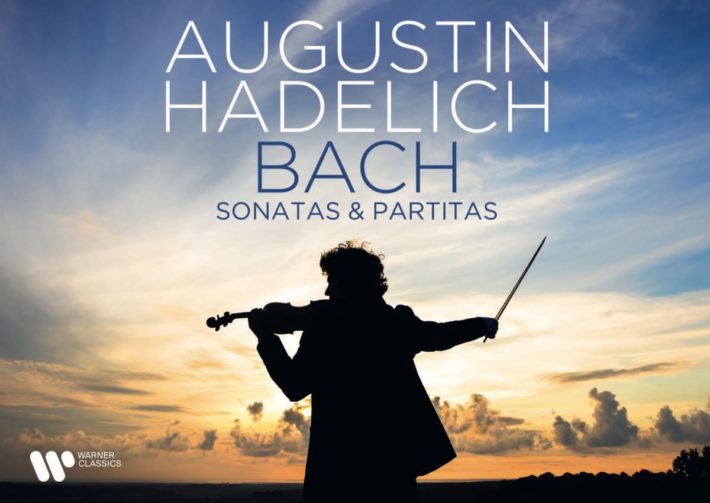For every virtuoso violinist or cellist, exploring Bach’s solo music marks a milestone in a musician’s journey. Violinist Augustin Hadelich adds to the wealth of available recordings of the Solo Violin Sonatas and Partitas by laying down his gauntlet in these most remarkable and admired of pieces.
Hadelich comments that he has spent much time with this masterpieces by Bach over the course of the pandemic of 2020. His familiarity and love of these works is evident in the playing. Hadelich plays a Guarneri “Leduc, ex Szeryng” violin, but replaces the modern bow for a baroque one. He explains how this aids the stopped notes, creating a more distinctive articulation. As he highlights further, the bow has limitations; for instance, producing a louder, bolder tone becomes more difficult as is noticeable throughout.
Programming alternating sonatas and partitas, Hadelich follows the tried and tested approach of esteemed violinists such as Alina Ibragimova, Julia Fischer and Thomas Zehetmair, who’s interesting set we reviewed here. Hadelich’s treatment of the Sonatas is different from the partitas; in the sonatas, he finds a subdued reverence, while in the partitas the character is distinctively different, bringing dance elements to the fore.
The performances, especially in the sonatas, I’ve found somewhat two dimensional. Although Hadelich brings light and shade, the gradations of tone and color lack nuances. This doesn’t mean the dynamics are overly simple, yet they don’t have the same spectrum as Podger or Ibragimova, as exemplified in the opening “allemanda” of the First Sonata, or the repeats in the “Gavotte” of the Third Partita. They are taken too literally, a missed opportunity to show the insight Hadelich brought in his successful ‘Bohemian Tales’ album, which we’ve covered here.
Related Classical Music Reviews
- Double Review: Chopin Piano Concertos – Grosvenor, Yundi
- Review: Chopin – Complete Nocturnes – Jan Lisiecki
- Review: Four Recent Chopin Albums (2021)
Hadelich’s arching approach is more concerned with the phrasing. While it’s considered and appropriate, there are moments when the inner voices lack prominence, as in the “fuga” of the Third Sonata. The subject entries all have a rigidity, while the episodes have a commendable spontaneity. In such episodes, the music radiates momentarily, revealing Hadelich’s interpretative insight, but the overall performance is disappointingly uneven, here and similarly across the entire album. One also notice the someone uneasiness with the shorter bow – The amount of vibrato Hadelich employs doesn’t always sit as comfortable with the period style he tries to emulate.
The famous Chaconne that closes the Second Partita is a masterclass in technical ability. The notes are executed with precision, but it is here especially that the range of tone and color is missing. The lower lines and the polyphony are not as distinctive. The phrasing, bowing and articulation is well considered and the entire performance comes across as being very introverted. The peaks, when the suspensions and dissonances resolve, are mostly too muted, and while Hadelich paces appropriately, the gravitas and significance of them are underplayed.
Some of Hadelich’s tempi, though appropriate to the music, don’t always bring the best out of the music. The opening “adagio” of the First Sonata feels a little laborious in comparison with Rachel Podger’s rhythmic details. The sarabandes of the First and Seconds Partitas sadly lack the communication between performer and listener and are not as evocative, feeling rather introverted. In the Third Partita, Hadelich shows impressive skill, yet the opening “preludio” is at times breathless because of the overly brisk tempo. Ibgramova, who also takes risks with tempi, finds greater subtly and variety in dynamics, and have the ability to voice the polyphonic lines with higher definition.
The recording is clear and made at a sufficient distance in the Fraser Performance Studio, WGBH Boston. What cannot be doubted is Hadelich’s technical assurance. He has all the skills necessary to play the notes with absolute security (his intonation is flawless throughout), but there isn’t the same interpretative prowess as other leading exponents. As a period choice, Podger is the undoubted forerunner with a greater technical control and an ability to elevate the more expressive nature of the pieces. Tetzlaff’s second recording is a curious and thought-provoking listen, but Tetzlaff’s pupil Ibragimova brings an approach which takes more risks, paying off with vibrancy and conviction.

Bach – Sonatas and Partitas for Solo Violin
Augustin Hadelich – Violin
Warner Classics, CD 9029504874
Recommended Comparisons
Read more classical music reviews or visit The Classic Review Amazon store
Follow Us and Comment:
Get our periodic classical music newsletter with our recent reviews, news and beginners guides.
We respect your privacy.








